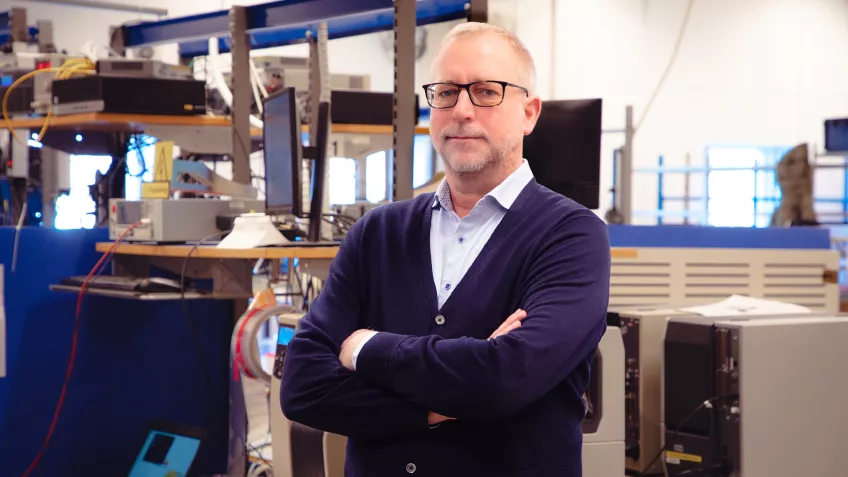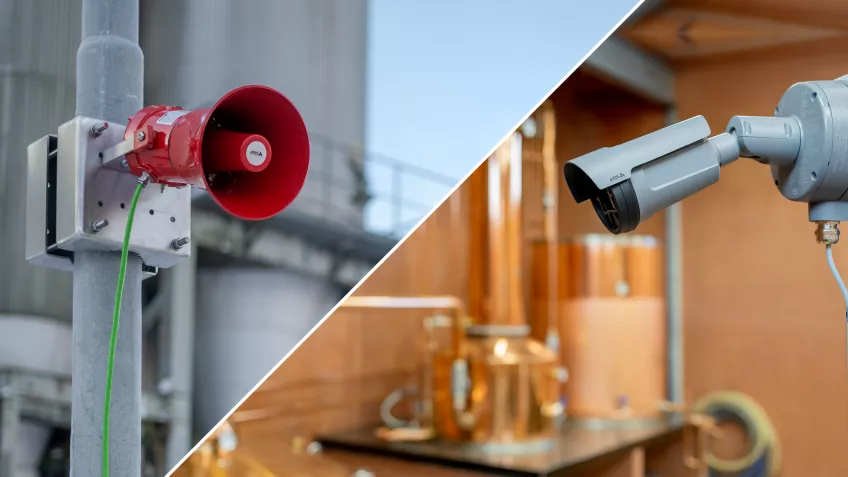
Hazardous areas classified as having an elevated risk of explosion can have an even greater need for monitoring and alert solutions. There’s a strong requirement to ensure health and safety, yet until relatively recently, the range of solutions available to enhance protection in these areas was limited. This demand set Axis on a path of development to optimize its products for hazardous environments.
We spoke to Jesper Olavi (right), Global Product Manager leading development of Axis’ explosion-protected product portfolio, Christian Loftorp (middle), General Manager of Axis Ex AB, Axis explosion-protected manufacturing subsidiary, and Håkan Sjöberg (left), Axis Regulatory Engineer integral to ensuring explosion-protection conformance. Learning about the monitoring and alert enhancement achieved through the Axis journey so far, we also asked them what the future holds for technology within the hazardous environment.
Why did Axis start developing explosion-protected devices?
Back in 2013, Axis started to get more and more requests from our customers in critical infrastructure to provide explosion-protected cameras. Primarily, it was the driver from customers to increase safety in hazardous areas liable to the risk of explosion, also known as Ex environments, that led to Axis’ decision to enter the market.
“The surveillance industry was rapidly converting from analog to network video, but the complicated certification requirements for explosion-protected devices and expensive deployment in hazardous areas meant that the majority of cameras were still analog,” says Jesper.
Convinced that network video is the future, Axis decided to develop an explosion-protected IP camera.
Initial development of an explosion-protected camera
The first Axis explosion-protected cameras were developed with a manufacturer of certified enclosures. Why did Axis choose this route?
“The focus was on Zone/Division 1, because this is the area with the highest explosion risk, and the greatest customer demand. The primary step to protect against electrical equipment, such as a network camera, causing an explosion in these designated areas is to surround it with an enclosure, containing any sparks or arcs that could ignite the atmosphere. Axis had no experience in designing explosion-protected cameras, so we decided that the fastest route to the market was by partnering with a company specialized in explosion-protected enclosures,” explains Jesper, who led the product development. “That allowed us to launch our first explosion-protected cameras in 2015, enabling us to get a better understanding of the unique requirements and use cases in hazardous areas.”

Development of in-house explosion-protected camera manufacturing
Axis management identified growth of the explosion-protected camera market coinciding with advances in camera analytics and computing power. This could increase value for partners and end users by driving operational efficiency benefits, as well as health and safety-focused use cases, within hazardous areas. In 2021, this led to Axis creating its own in-house subsidiary, Axis Ex, to manufacture cameras for hazardous areas according to international standards, with certifications including ATEX, IECEx, METLabs.
“After a few years we saw the limitations of adapting our cameras to fit into external enclosures, and realized that for us as camera manufacturer, it made more sense to design the enclosure to fit the camera instead,” says Jesper.
This approach allows us to provide better products and solutions to our customers, shorten lead times and service our global partners and customers in a more efficient way.
It took significant investment from Axis to establish its in-house explosion-protected camera manufacturing capability, both in R&D and manufacturing to support the long-term commitment to providing the best solutions for hazardous areas.
“The engineers at R&D worked in close collaboration with regulatory experts to ensure that the products fulfill the many standards and directives that explosion-protected products must be tested, to achieve the goal of providing world-wide certification on each model. This allows our global customers to choose the same part number all over the world,” explains Jesper.
To manufacture the products, achieving the right processes is also crucial to the creation of the in-house explosion-protected products capability.
“A company manufacturing explosion-protected products need to have an externally audited quality management system based on ISO 9001. On top of that, explosion-protected certification in various parts of the world sometimes require additional audits,” adds Christian. “Before placing an explosion-protected product on the market, the design is evaluated against the standards, and then subjected to various environmental tests to ensure that it is safe for use under any foreseeable circumstance in a hazardous area.”
After the design has been approved, the manufacturer needs to ensure that subsequent volume production is identical to the tested prototypes, for a minimum of 10 years, and the processes and work instructions to ensure this are controlled by the quality management system.
Innovations generated by in-house development
With complete control over design as well as manufacturing, Axis is also able to develop products and solutions for the less hazardous Zone/Division 2 areas using a different explosion-protection method. This new approach diverges from the norm but generates a variety of benefits that more closely respond to customer requirements.

Right: AXIS XC1311, Axis first explosion-protected network horn speaker certified for use in Zone and Division 1 hazardous locations.
“The market required a Zone/Division 2 camera, but until a camera manufacturer established the in-house capability, its development wasn’t possible,” says Jesper. “The combination of explosion protection requirements with camera expertise was necessary to create the optimal design.”
In-house manufacture of explosion-protected products, including streamlining of the production process and actual product itself, compared to involving a third-party enclosure manufacturer, also achieves a significantly shorter lead time, as well as wider benefits for the customer.
“In-house manufacturing of cameras for hazardous areas has enabled us to certify products globally. This means fewer part numbers, so we can achieve greater stock holding, and simplify product selection and supply for customers operating worldwide,” says Christian. “Instead of relying on a third-party, in-house manufacture also achieves a cost saving that we can pass on to partners and customers.”
Future development for a smarter, safer world
Axis’ in-house explosion-protected development and manufacturing capability enables the expansion of explosion-protection to wider products and solutions.
“Taking full control over all aspects of explosion-protected product design, certification and manufacturing opens up a lot of interesting opportunities for Axis to continue innovating for a smarter, safer world,” says Jesper. “Now, we’ve added thermometric cameras that can monitor exact temperatures from a distance, alerting whenever a temperature varies outside a set span. And once a camera detects an anomaly, either via a visual or thermal approach, it could send out a message through an explosion-protected network speaker, such as warning against movement into a restricted area, or alerting about an overheating machine.“
Advanced computing technology also now means that cameras deployed in a surveillance role act as high functioning sensors, bringing further development opportunities to partners. With deep learning analytics, AXIS Camera Application Platform (ACAP) partners can also develop specific functionality for hazardous areas. In the oil & gas sector, for example, engineers can now ‘train’ a camera to identify conditions necessary to ensure optimal drilling for safety and efficiency.
“All you need is the right input signal, working in union with the camera’s deep learning capability,” says Jesper. “Developing analytics, alongside integration of the right inputs, can help you make better decisions in your working processes, gaining operational efficiencies and further improving safety.”
Axis continues to develop new capabilities from its Ex environment devices, such as integrating PPE monitoring.
“We’re always striving to increase the value customers receive from our products towards the creation of a smarter, safer world,” says Jesper.
